Antiquities - ESO

Antiquities Overview
Antiquities are historical treasures hidden all over Tamriel and beyond, just waiting for you to learn about them. The Antiquities system allows you to search for these lost, forgotten, and valuable objects—to catalog them, learn about their lore, and to reap the incredible rewards.Antiquities are available only to players who have access to the Greymoor DLC. Players who do not have access to the Greymoor DLC can discover Leads for Antiquities, but can't join the Antiquarian Circle—and thus, they cannot Scry for or excavate those Antiquities. Players who finished the Antiquarian tutorial and who lose access to this DLC retain ownership of the Antiquarian's Eye collectible, retains progress in Antiquities skill lines and Leads, but cannot Scry.To begin your journey as an Antiquarian, you'll need to visit the Antiquarian Circle, found in Solitude, in Western Skyrim. There, you'll find Verita Numida, who will start you on your path.
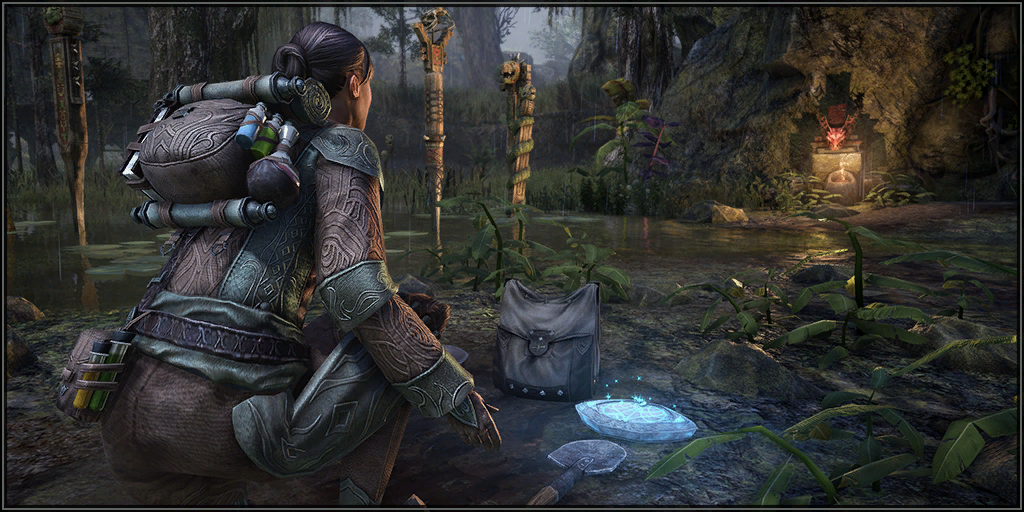
Antiquities Codex
The Antiquities Codex allows you to see all of the Antiquities you can Scry for, and all of the Antiquities you previously uncovered. Any time you want to search for an Antiquity, the Codex should be your first stop.The first entry in the Antiquities Codex is the Scryable list. This list displays all of the Antiquities you can currently search for. Select an Antiquity from this list to begin Scrying. Remember that you can only Scry for Antiquities found in the zone you're currently standing in!
The remaining entries in the Codex list Antiquities by zone. This list allows you to see what Antiquities you've found, how many times you've found them, and any Lore Entries you've uncovered for those Antiquities.
Every Antiquity has at least one Lore Entry associated with it. You'll uncover a Lore Entry by successfully excavating that Antiquity. Some Antiquities have more than one Lore Entry; in that case, you'll uncover a new Entry every time you successfully excavate it, until you've found them all.Some Antiquities are fragmented into multiple parts.
Each fragment of an Antiquity will have its own Lore Entry, and will require its own Lead. For all intents and purposes, even just a scrap of that forgotten object is an Antiquity unto itself.
Once you've found all of the fragments of an Antiquity, they will automatically combine to create the final Antiquity.
Leads
When you first begin your journey as an Antiquarian, your Antiquities Codex will appear rather sparse. This is because the majority of Antiquities are hidden!In order to learn about the existence of these undiscovered Antiquities, you'll need to uncover Leads. Most Antiquities require you to find a Lead before you can Scry for them.
Excavating a hidden Antiquity consumes its Lead, so you'll need to find another Lead to Scry for that Antiquity again. However, your Codex will retain all the details you've learned about that Antiquity so far.
You can find Leads all over Tamriel and beyond. Try speaking with merchants, exploring the world, searching for treasure chests, slaying Bosses, fishing, stealing . Antiquity Leads can pop up almost anywhere!
One final note: Leads will expire after a long period of time, so be sure to track down hidden Antiquities in a timely fashion!
Scrying
The first step in uncovering an Antiquity is Scrying for it. Gazing into the Antiquarian's Eye will allow you to expand your awareness and mystically search for these hidden treasures.In order to Scry for an Antiquity, you must be in the same Zone as the Antiquity, and you must have a relevant Lead (if the Antiquity requires it).
To begin Scrying, open your Codex and select the Antiquity you wish to Scry for from the Scryable list. (If the Antiquity does not appear on that list, you cannot Scry for it.) Once you've made your selection, you'll be taken to a view of the Antiquarian's Eye.When Scrying for an Antiquity with the Antiquarian's Eye, you begin at the large crystal in the bottom-middle. This crystal indicates how many turns you have remaining. When the crystal is totally depleted, your Scrying session ends.
Your goal is to claim the glowing Foci scattered across the lens. Every Foci you claim eliminates one possible Dig Site from your map, narrowing and expediting your search. You must acquire at least one Foci to begin searching for the Antiquity.
To move toward the Foci, select a facet adjacent to your area of control. This will add that facet—and all facets of the same type that touch it—to your owned area. In this way, you can claim more and more facets as you Scry.
If you don't acquire all the Foci, you can return to the Codex and Scry for the same Antiquity again. There is no cost associated with trying again, and obtaining more Foci the second time will narrow down the Antiquity's possible locations.

Locating the Antiquity
Once you successfully Scry for an Antiquity, you'll need to venture out into the world in order to find it.To begin with, open your Zone Map. The map will display a number of "Dig Sites." Only one of these Dig Sites contain the Antiquity. The more Foci you obtain while Scrying, the fewer Dig Sites will appear on the map—down to just one, if you claimed all the Foci.
Once you venture to a Dig Site, your compass will glow, much like a Quest step that requires you to search the area. In much the same way, you'll need to investigate your surroundings to find the Antiquity's resting place.
You can use the Antiquarian's Eye from your Quickslot, or from your Collections menu, to point the way toward the nearest possible location for the Antiquity. However, you can only call on the Antiquarian's Eye in this way every so often, so be sure to look around while you search.
The visible cue you're looking for is a mound of dirt with subtle sparkles floating upwards from it. The dirt may match the terrain's coloration, so keep a sharp eye out. Purchasing the Keen Eye passive may help you spot these dirt mounds more quickly.Once you've found a suspicious pile of dirt, interact with it.
If it is not the Antiquity's actual location, you'll find some simple Treasure, and that Dig Site will disappear from your map. This means the Antiquity is resting in some other location.
If a dirt pile does contain the Antiquity, you will enter the Excavation phase of your journey.
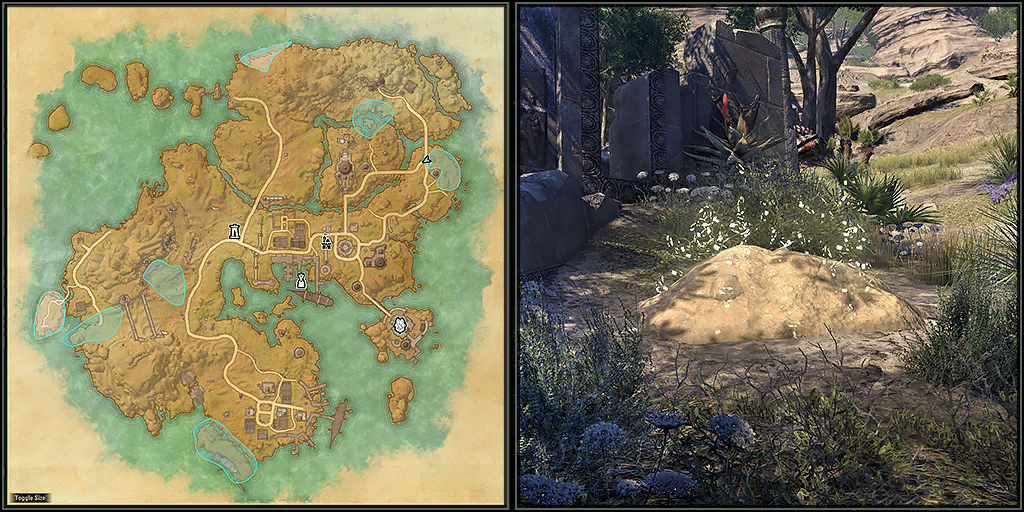
Excavation
The last step in acquiring an Antiquity is Excavation. During an Excavation, you work to remove the Antiquity from the dirt, without breaking it, and within the time allotted.To begin an Excavation, you must first Scry for the Antiquity, and then locate its exact burial spot within its Dig Site. Once you interact with the Antiquity's dirt mound, the Excavation begins.
You have a limited number of actions you can take during an Excavation, indicated by the Intuition meter at the top of the screen, and by the daylight remaining. When you've used up your limited actions, the dig is over.
If you fail to Excavate an Antiquity (whether by breaking it, or by running out of turns), the Dig Site will disappear. Don't worry, though. You can find it again, somewhere within the same Dig Site on your map.The first phase of an Excavation involves locating the Antiquity's location within the dirt, using the Antiquarian's Eye to Augur for it. When you Augur, the chunk of dirt you select will light up. The brighter and greener the light, the closer that chunk is to the Antiquity, with brilliant green indicating the Antiquity's exact location.
Once you've located the Antiquity, you'll need to uncover it, using your Hand Brush. In lower-difficulty Excavations, the Hand Brush alone can uncover the sought Antiquity. More challenging Excavations, however, require the use of other tools, which you can unlock by leveling up the Antiquarian skill line.
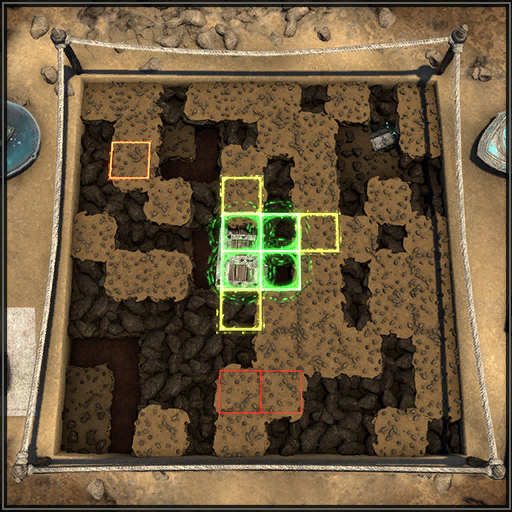
Advanced Excavation
Attempting to excavate more difficult Antiquities often leads to new challenges.First, you will find that many Antiquities are buried near additional items, known as Bonus Loot. These rewards—while not as valuable as an Antiquity—still provide added benefit to your Excavation.
After you excavate an Antiquity, you can continue to dig for any Bonus Loot still hidden in the dirt. Note, however, that the Augur skill does not reveal Bonus Loot, and you can only keep Bonus Loot if you successfully excavate the Antiquity.
You may also stumble upon Fissures; these small pockets of volatile gas often appear near rarer Antiquities. Removing the last chunk of dirt from a fissure will trigger a detonation, damaging the Antiquity. Upgrading the Trowel can turn these explosions to your benefit by removing large amounts of dirt in a single action. But be wary—these explosions can break an Antiquity and end your excavation in an instant.As you advance the Excavation skill line, you'll unlock additional tools to aid you in your digging efforts. Both of these tools require you to build up Intuition by using the Hand Brush, and both depend on the elevation of the chunks surrounding where you use them, so be sure to plan your moves carefully.
The Trowel allows you to dig deeply, removing several layers of dirt and rock from a single chunk of the Excavation site. Once upgraded, it can safely trigger Fissures, allowing you to control their detonation, and even chain their explosions together!
The Heavy Shovel can remove a large area of dirt in a single action. It only affects adjacent chunks of the same height as the chunk you select. Use Heavy Shovel to flatten an area quickly, or to remove huge amounts of soil in a hurry. Once upgraded, you have a chance to not consume any Intuition when you use the Heavy Shovel.
Excavation: Augury
Once you've begun an Excavation, you'll want to determine the Antiquity's exact location using the Augur skill. First, select the Antiquarian's Eye on the Excavation screen to use your Augur skill. Then, select a chunk of dirt to Augur. A glow indicating the Antiquity's distance from the selected chunk will appear, as shown on the image below.There are 4 types of indicators:• A faint red outline with no glow: indicates that the Antiquity is at least five chunks of dirt away.
• An orange outline with a subtle glow: indicates that the Antiquity is 3-4 chunks of dirt away.
• A yellow outline with a strong glow: indicates the Antiquity is nearby, 1-2 chunks of dirt away.
• Finally, a bright green outline with a strong, pulsating glow: indicates the Antiquity is directly beneath the Augured chunk.
You can only use your Augur skill a limited number of times during an Excavation. However, using the Augur skill does not consume your limited number of turns for the Excavation, so don't be afraid to use this important skill to give yourself an edge.
Finally, keep in mind: at first, your Augur skill can only detect the Antiquity starting from the lowest, darkest layers of dirt in an Excavation. Once upgraded, it can detect the Antiquity through the middle and lowest layers. This means you may need to remove some dirt before you can successfully Augur for the Antiquity.
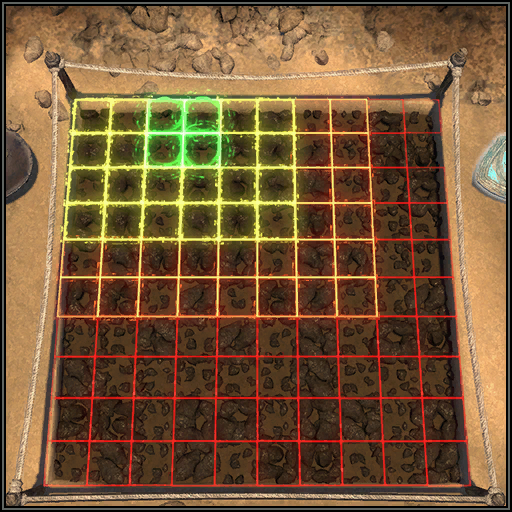
Excavation: Fissures
When excavating rarer Antiquities, you may encounter Fissures: vents of volatile gas. Removing the last layer of rock or dirt from a Fissure's space will cause it to detonate, damaging the Antiquity. Without the proper tools, it's best to avoid Fissures.However, with an upgraded Trowel, you can turn Fissures to your advantage.If an upgraded Trowel is used to expose a Fissure, it will not deal damage to the Antiquity. Furthermore, if two Fissures can be connected by a path of dirt and rocks that are at exactly the same height, exposing the Fissure will cause an explosive chain reaction! Every chunk between the two Fissures will be destroyed, allowing you to remove huge amounts of dirt in one fell swoop.
However, be warned: if the path between two exploding Fissures crosses directly over any part of the Antiquity, the Antiquity will be completely destroyed—instantly ending the Excavation in failure.
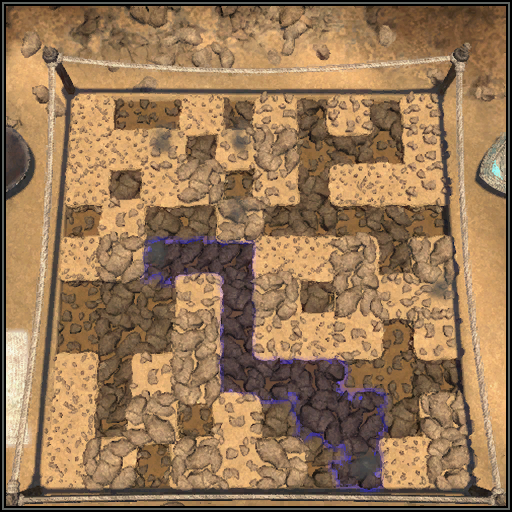
Help articles
68 articles
-

-

-

-

-

-

-

-

-

-

-

-

-

-

-

-

-

-

-

-

-

-

-

-

-

-

-

-

-

-

-

-

-

-

-

-

-

-

-

-

-

-

-

-

-

-

-

-

-

-

-

-

-

-

-

-

-

-

-

-

-

-

-

-

-

-

-

-

 Deutsch
Deutsch
 Français
Français
 Русский
Русский
 Español
Español

















































































































































































































































































































